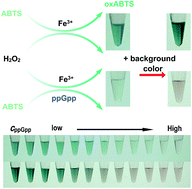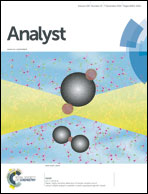Selective and sensitive colorimetric detection of stringent alarmone ppGpp with Fenton-like reagent†
Abstract
Stringent alarmone, namely, guanosine 3′-diphosphate-5′-diphosphate (ppGpp), is a global regulator that plays a critical role in the survival, growth, metabolism, and many other vital processes of microorganisms. Because of its structural similarity to normal nucleotides, it is also a challenge for the selective and sensitive detection of ppGpp nowadays. Herein, we developed a colorimetric method for the selective detection of ppGpp by inhibiting the redox reaction between Fenton-like reagent (composed of Fe3+ and H2O2) with 2,2′-azino-bis(3-ethylbenzthiazoline-6-sulfonic acid) (ABTS). Owing to the strong coordination affinity between ppGpp and Fe3+, the chromogenic reaction between ABTS and Fenton-like reagent, occurred in aqueous medium at 37 °C and resulted in a bluish-green solution, which was inhibited with the addition of ppGpp. This phenomenon forms the basis for the colorimetric detection of ppGpp, with a detection limit of 0.19 μM and good selectivity for ppGpp over other nucleotides and anions. Furthermore, the results could be visualized by the naked eye, and the sensitivity of the naked-eye observation could even be further improved with the aid of the introduction of a background color.


 Please wait while we load your content...
Please wait while we load your content...